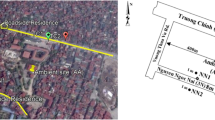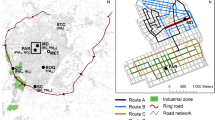Abstract
The size of particles in urban air varies over four orders of magnitude (from 0.001 μm to 10 μm in diameter). In many cities only particle mass concentrations (PM10, i.e. particles <10 μm diameter) is measured. In this paper we analyze how differences in emissions, background concentrations and meteorology affect the temporal and spatial distribution of PM10 and total particle number concentrations (PNC) based on measurements and dispersion modeling in Stockholm, Sweden. PNC at densely trafficked kerbside locations are dominated by ultrafine particles (<0.1 μm diameter) due to vehicle exhaust emissions as verified by high correlation with NOx. But PNC contribute only marginally to PM10, due to the small size of exhaust particles. Instead wear of the road surface is an important factor for the highest PM10 concentrations observed. In Stockholm, road wear increases drastically due to the use of studded tires and traction sand on streets during winter; up to 90% of the locally emitted PM10 may be due to road abrasion. PM10 emissions and concentrations, but not PNC, at kerbside are controlled by road moisture. Annual mean urban background PM10 levels are relatively uniformly distributed over the city, due to the importance of long range transport. For PNC local sources often dominate the concentrations resulting in large temporal and spatial gradients in the concentrations. Despite these differences in the origin of PM10 and PNC, the spatial gradients of annual mean concentrations due to local sources are of equal magnitude due to the common source, namely traffic. Thus, people in different areas experiencing a factor of 2 different annual PM10 exposure due to local sources will also experience a factor of 2 different exposure in terms of PNC. This implies that health impact studies based solely on spatial differences in annual exposure to PM10 may not separate differences in health effects due to ultrafine and coarse particles. On the other hand, health effect assessments based on time series exposure analysis of PM10 and PNC, should be able to observe differences in health effects of ultrafine particles versus coarse particles.
Similar content being viewed by others
References
CEPMEIP. (2002). Co-ordinated European Programme on Particulate Matter Emission Inventories, (http://www.air.sk/ tno/cepmeip/).
Charron, A., & Harrison, R.M. (2003). Primary particle formation from vehicle emissions during exhaust dilution in the roadside atmosphere. Atmospheric Environment, 37, 4109–4119.
Chow, J.C., Watson, J.G., Lowenthal, D.H., & Countess, R.J. (1996). Sources and chemistry of PM10 aerosol in Santa Barbara County, CA. Atmospheric Environonment, 30(9), 1489–1499.
Danard, M. (1977). A simple model for mesoscale effects of topography on surface winds. Monthly Weather Review, 99, 831–839.
Englert, N. (2004). Fine particles and human health–a review of epidemiological studies. Toxicology Letters, 149 235–242.
Forsberg, B., Hansson, H.-C., Johansson, C., Areskoug, H., Persson, K., & Järvholm, B. (2005). Comparative health impact assessment of local and regional particulate air pollutants in Scandinavia. Ambio, 34, 11–19.
Garg, B.D., Cadle, S.H., Mulawa, P.A., & Groblicki, P.J. (2000). Brake wear particulate matter emissions. Environmental Science & Technology, 34, 4463–4469.
Gidhagen, L., Johansson, C., Langner, J., & Olivares, G. (2004). Simulation of NOx and ultrafine particles in a street Canyon in Stockholm, Sweden. Atmospheric Environment, 38, 2029–2044.
Gidhagen, L., Johansson, C., Langner, J., & Foltescu, V. (2005). Urban scale modeling of particle number concentration in Stockholm. Atmospheric Environment, 39, 1711–1725.
Gomiscek, B., Hauck, H., Stopper, S., & Preining, O. (2004). Spatial and temporal variations of PM1, PM2.5, PM10 and particle number concentration during the AUPHEP–project, Atmospheric Environment, 38, 3917–3934.
Harrison, R.M., Shi, Ji Ping, & Jones, M.R. (1999). Continuous measurements of aerosol physical properties in the urban atmosphere. Atmospheric Environment, 33, 1037–1047.
Harrison, R.M., Deacon, A.R., & Jones, M.R. (1997). Sources and processes affecting concentrations of PM10 and PM2.5 particulate matter in Birmingham (UK). Atmospheric Environment, 31, 4103–4117.
Hoek, G., Brunekreef, B., Goldbohm, S., Fischer, P., & van den Brandt, P.A. (2002). Association between mortality and indicators of traffic-related air pollution in the Netherlands: a cohort study. Lancet, 360, 1203–1209.
Jacobson, T. (1994). Investigation of the road wear and light reflection characteristics of different road surfaces. (Only in Swedish: Undersökning av slitstyrkan och ljusreflektionsegenskaper hos vägbeläggning: Försök i VTIs provvägsmaskin). The Swedish National Road and Transport Research Institute (VTI), Report Notat 47–94, Linköping, Sweden.
Johansson, C., Hadenius, A., Johansson, P.-Å., & Jonson, T. (1999). The Stockholm study on Health effects of Air Pollution and its Economic Consequences. Part I. NO2 and Particulate Matter in Stockholm. AQMA Report 6:98, Stockholm Environment and Health Protection Administration, Box 38 024, 100 64 Stockholm, Sweden.
Ketzel, M., Louka, P., Sahm, P., Guilloteau, E., Sini, J.-F., & Moussiopoulos, N. (2002). Intercomparison of numerical urban dispersion models—part II: street canyon in Hannover, Germany. Water, Air, and Soil Pollution: Focus, 2, 603–613.
Ketzel, M., Wåhlin, P., Berkowicz, R., & Palmgren, F. (2003a). Particle and trace gas emission factors under urban driving conditions in Copenhagen based on street and roof-level observations. Atmospheric Environment, 37, 2735– 2749.
Ketzel, M., Wåhlin, P., Kristensson, A., Swietlicki, E., Berkowicz, R., Nielsen, O.J., & Palmgren, F. (2003b). Particle size distribution and particle mass measurements at urban, near-city and rural level in the Copenhagen area and Southern Sweden. Atmos. Chem. Phys. Discuss., 3, 5513–5546. (www.atmos-chem-phys.org/acpd/3/5513/).
Keywood, M.D., Ayers, G.P., Gras, J.L., Gillett, R.W., & Cohen, D.D. (1999). Relationships between size segregated mass concentration data and ultrafine particle number concentrations in urban areas, Atmospheric Environment, 33, 2907–2913.
Krzyzanowski, M., Cohen, A., Anderson, R., & WHO Working Group. (2002). Quantification of health effects of exposure to air pollution. Occupational and Environmental Medicine, 59(12), 791–793.
Kukklonen, J., Härkönen, J., Karpinen, A., Pohjola, M., Pietarila, H., & Koskentalo, T. (2001). A semi-empirical model for urban PM10 concentrations, and its evaluation against data from an urban measurement network. Atmospheric Environment, 35, 4433–4442.
Lenschow, P., Abraham, H.-J., Kutzner, K., Lutz, M., Preuss, J.-D., & Reichenbächer, W. (2001). Some ideas about the sorces of PM10. Atmospheric Environment, 35(Supplement no. 1), 823–833.
Longley, I.D., Gallagher, M.W., Dorsey, J.R., Flynn, M., Allan, J.D., Alfarra, M.R., & Inglis, D. (2003). A case study of aerosol (4.6 nm <Dp < 10 μm) number and mass size distribution measurements in a busy street canyon in Manchester, UK, 2003. Atmospheric Environment, 37, 1563–1571.
Mårtensson, E.M., Nilsson, E.D., Buzorius, G., & Johansson, C. (2006). Eddy correlation measurements and parameterisation of particle emissions in an urban environment. Atmospheric Chemistry & Physics, 769–785, DOI: 1680-7324/acp/2006-6-769.å.
Molnár, P., Janhäll, S., & Hallquist, M. (2002). Roadside measurements of fine and ultrafine particles at a major road north of Gothenburg. Atmospheric Environment, 36, 4115–4123.
Nafstad, P., Lund Håheim, L., Wisløff, T., et al. (2004). Urban air pollution and mortality in a cohort of norwegian men. Environ Health Perspect., 112, 610–615.
Norman, M., & Johansson, C. (2006). Studies of some measures to reduce road dust emissions from paved roads in Scandinavia. Atmospheric Environment, in press.
Omstedt, G., Bringfelt, B., & Johansson, C. (2005). A model for vehicle induced non-tailpipe emissions of particles along Swedish roads. Atmospheric Environment, 39, 6088–6097.
Pakkanen, T., Veli-Matti Kerminen, A., Korhonen, Christina H., Hillamo, Risto E., Aarnio, Päivi, Koskentalo, Tarja, & Maenhaut, Willy. (2001). Use of atmospheric elemental size distributions in estimating aerosol sources in the Helsinki area. Atmospheric Environment, 35, 5537–5551.
QUARG. (1996). Airborne particulate matter in the United Kingdom. Quality of urban air review group, University of Birmingham, School of Chemistry, Edgbaston, Birmingham, UK. ISBN 0 9520771-3-2.
Pitz, M., Kreyling, W.G., Hölscher, B., Cyrys, J., Wichmann, H.E., & Heinrich, J. (2001). Change of the ambient particle size distribution in East Germany between 1993 and 1999. Atmospheric Environment, 35, 4357–4366.
Pope, C.A., 3rd, Thun, M.J., Namboodiri, M.M., Dockery, D.W., Evans, J.S., Speizer, F.E., et al. (1995). Particulate air pollution as a predictor of mortality in a prospective study of US adults. American Journal of Respiratory Critical Care Medicine, 151, 669–674.
Querol, X., Alastuey, A., Ruiz, C.R., Artiñano, B., Hansson, H.C., Harrison, R.M., Buringh, E., ten Brink, H.M., Lutz, M., Bruckmann, P., Straehl, P., & Schneider, J. (2004). Speciation and origin of PM10 and PM2.5 in selected European cities. Atmospheric Environment, 38, 6547–6555.
Rogge, W.F., Hildemann, L.M., Mazurek, M.A., & Cass, G.R. (1993). Sources of fine organic aerosol. 3. Road dust, tire debris, and organometallic brake lining dust: roads as sources and sinks. Environmental Science and Technology, 27, 1892–1904.
Shi, J.P., Khan, A.A., & Harrison, R.M. (1999). Measurements of ultrafine particle concentration and size distribution in the urban atmosphere. Science of Total Environment, 235, 51–64.
Tuch, Th., Brand, P., Wichmann, H.E., & Heyder, J. (1997). Variation of particle number and mass concentration in various size ranges of ambient aerosols in eastern Germany. Atmospheric Environment, 31, 4193–4197.
Tunved, P., Hansson, H.-C., Kulmala, M., Aalto, P., Viisanen, Y., Karlsson, H., Kristensson, E., & Swietlicki, M., et al. (2003). One year boundary layer aerosol size distribution data from five Nordic background stations. Atmos. Chem. Phys., 3, 2183–2205.
Van Dingenen, R., Raes, F., Putaud, J.-P., Baltensperger, U., Charron, A., Facchini, M.-C., Decesari, S., Fuzzi, S., Gehrig, R., Hansson, H.-C., et al. (2004). A European aerosol phenomenology–1: physical characteristics of particulate matter at kerbside, urban, rural and background sites in Europe. Atmospheric Environment, 38, 2561–2577.
Westerlund, K.G., & Johansson, C. (2002). Emissions of metals and particulate matter due to wear of brake linings in Stockholm. In: Brebbia, C.A., & Martin-Duque, J.F. (eds.), Air Pollution X. Southampton, UK: WIT Press, ISBN 1-85312-916-X.
Author information
Authors and Affiliations
Corresponding author
Rights and permissions
About this article
Cite this article
Johansson, C., Norman, M. & Gidhagen, L. Spatial & temporal variations of PM10 and particle number concentrations in urban air. Environ Monit Assess 127, 477–487 (2007). https://doi.org/10.1007/s10661-006-9296-4
Received:
Accepted:
Published:
Issue Date:
DOI: https://doi.org/10.1007/s10661-006-9296-4




